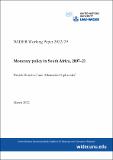| dc.contributor.author | Patrick, Honohan | |
| dc.contributor.author | Orphanides, Athanasios | |
| dc.date.accessioned | 2022-03-18T17:30:39Z | |
| dc.date.available | 2022-03-18T17:30:39Z | |
| dc.date.issued | 2022-03-18 | |
| dc.identifier.uri | https://hdl.handle.net/1721.1/141296 | |
| dc.description.abstract | This paper reviews South Africa’s monetary policy since 2007 and makes recommendations towards improving the inflation-targeting framework currently in place. Following a surge in inflation into double digits in 2007/08, the South African Reserve Bank managed to guide inflation in line with the 3–6 per cent target band. Estimates of South Africa’s
potential output underwent successive downward revisions. The resulting output gap misperceptions contributed to the tendency of inflation to be closer to the upper edge of the band in the 2010s. Our assessment is that the current definition of the target is not ambitious enough and reduces the benefits that inflation targeting could otherwise provide. An eventual point target of 3 per cent would better promote growth and protect the value of the currency, as mandated by the Republic’s Constitution. | en_US |
| dc.language.iso | en_US | en_US |
| dc.relation.ispartofseries | MIT Sloan School of Management Working Paper; | |
| dc.relation.ispartofseries | United Nations University;WIDER Working Paper 2022/29 | |
| dc.rights | Attribution-NonCommercial-NoDerivs 3.0 United States | * |
| dc.rights.uri | http://creativecommons.org/licenses/by-nc-nd/3.0/us/ | * |
| dc.subject | Monetary Policy, Inflation Targeting, Output Gap Misperceptions, South Africa | en_US |
| dc.title | Monetary Policy in South Africa, 2007-21 | en_US |
| dc.type | Working Paper | en_US |
